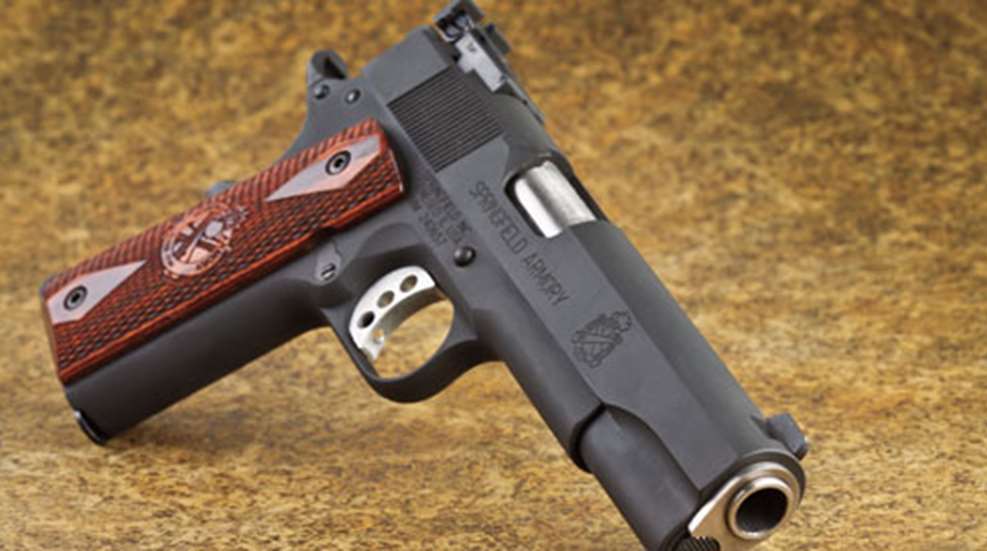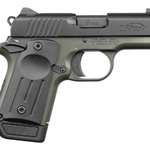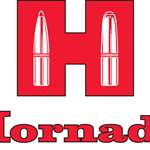
Competitive pistol shooting can be an expensive endeavor. High-end guns account for the bulk of initial costs, which is a reason why many people do not get involved—despite their interest in the sport. Springfield Armory recognized that void in the market and created the Range Officer: a .45 ACP M1911 made with the same materials, fit and quality as its higher-end Tactical Response Pistol (TRP), but lacking some amenities found on the TRP and other, more expensive guns in Springfield’s line. The Range Officer (RO) is a pistol designed primarily for amateur competitors who want a reliable, well-fit base-model M1911, at a reasonable price, that is ready for competition.
The slide and the frame are Parkerized, hammer-forged 4140 steel. The 5-inch barrel and barrel bushing are stainless steel. All internal parts are steel except the titanium firing pin and the aluminum trigger, which is skeletonized and features an overtravel adjustment screw. Torx screws hold the cocobolo hardwood stocks to the frame. The Integral Locking System (ILS), a standard feature on all Springfield M1911s, is activated with an included key on the rear of the mainspring housing. Turning it locks the mainspring, preventing the hammer from being cocked and the slide from retracting.
The RO’s controls and mechanics are standard M1911. There is no Series 80-type firing pin block. The mainspring is especially strong, requiring a concerted effort to cock the skeletonized hammer, but it easily provides the force needed for reliable ignition. Also, the recoil spring is about 1-inch longer than that in some lower-priced Springfield M1911s, adding to the force needed to rack the slide and allowing the gun to better-handle higher-velocity loads. It has a standard-length guide rod.
The flat mainspring housing has 20-l.p.i. checkering, and there are serrations on the slide stop, the extended safety lock, the magazine release, the trigger, the hammer and the rear sides of the slide. Machine cuts include a flared, lowered ejection port and a slightly beveled magazine well. The sights are dovetailed into the slide, which required an additional cut on the top rear, and the Bo-Mar-style rear sight is adjustable for windage and elevation. The deep, sharp, angled serrations on the slide provided exceptional purchase; the operation of the thumb safety was smooth and positive; and the beveling on the magazine well, although minimal, noticeably aided quick magazine changes. An additional cut in the barrel hood functions as a loaded-chamber indicator.
We found the fit of the barrel, the slide, the frame and the internal parts to be favorable. Play between the frame and slide was almost indiscernible, even with the slide slightly retracted, but it was not as tight as some higher-end M1911s. The barrel link, barrel lugs and barrel-lug recesses were sharp and well-fit, adding to the overall positive lock-up. We found no burrs anywhere, and the edges were softened on the front of the dustcover, as well as along the front, rear and sides of the slide.
There was a slight take-up with the trigger, followed by a sharp break with a trigger pull measuring 5 pounds, 12 ounces. Staff members who prefer Springfield’s High Hand beavertail grip safety, palm pad and flat mainspring housing found them comfortable. Overall we had a positive view on the gun’s form and function.
We fired about 80 rounds, and then cleaned and oiled the gun before accuracy testing. During about 250 rounds of testing, there was only one failure to chamber. Shooting from a sandbag with post-and-notch sights may not reveal a gun’s full accuracy potential, but nonetheless the gun exhibited acceptable accuracy for amateur competition. A five-shot, 1.81-inch group at 25 yards is commendable, so with the right ammunition in the right conditions the gun is on par with higher-end competition pistols.
With competition in mind, in our opinion the trigger should be lightened and checkering should be added to the frontstrap. Going more toward a practical role, welcome options would include fast-acquisition sights and an arched mainspring housing. With its ability to accept these changes and a host of aftermarket upgrades through the Springfield Custom Shop, however, it is difficult to criticize the gun outside of its inconformity with mere personal preferences. It is an excellent model for recreation, IDPA matches and other such competitive endeavors.
Manufacturer: Springfield Armory; (800) 680-6866; www.springfield-armory.com
Caliber: .45 ACP
Action: recoil-operated, single-action, center-fire semi-automatic pistol
Frame: hammer-forged 4140 steel
Barrel: stainless steel
Rifling: six-groove, 1:16" LH twist
Magazine: blued steel detachable box, seven rounds
Sights: dovetailed, adjustable Bo-Mar-style post-and-notch
Trigger Pull: single-action; 5 lbs., 12 ozs.
Stocks: cocobolo hardwood
Overall Length: 8½"
Width: 15⁄16"
Height: 5½"
Weight: 2 lbs., 8 ozs.
Accessories: extra magazine, lock, owner’s manual
Suggested Retail Price: $939





































